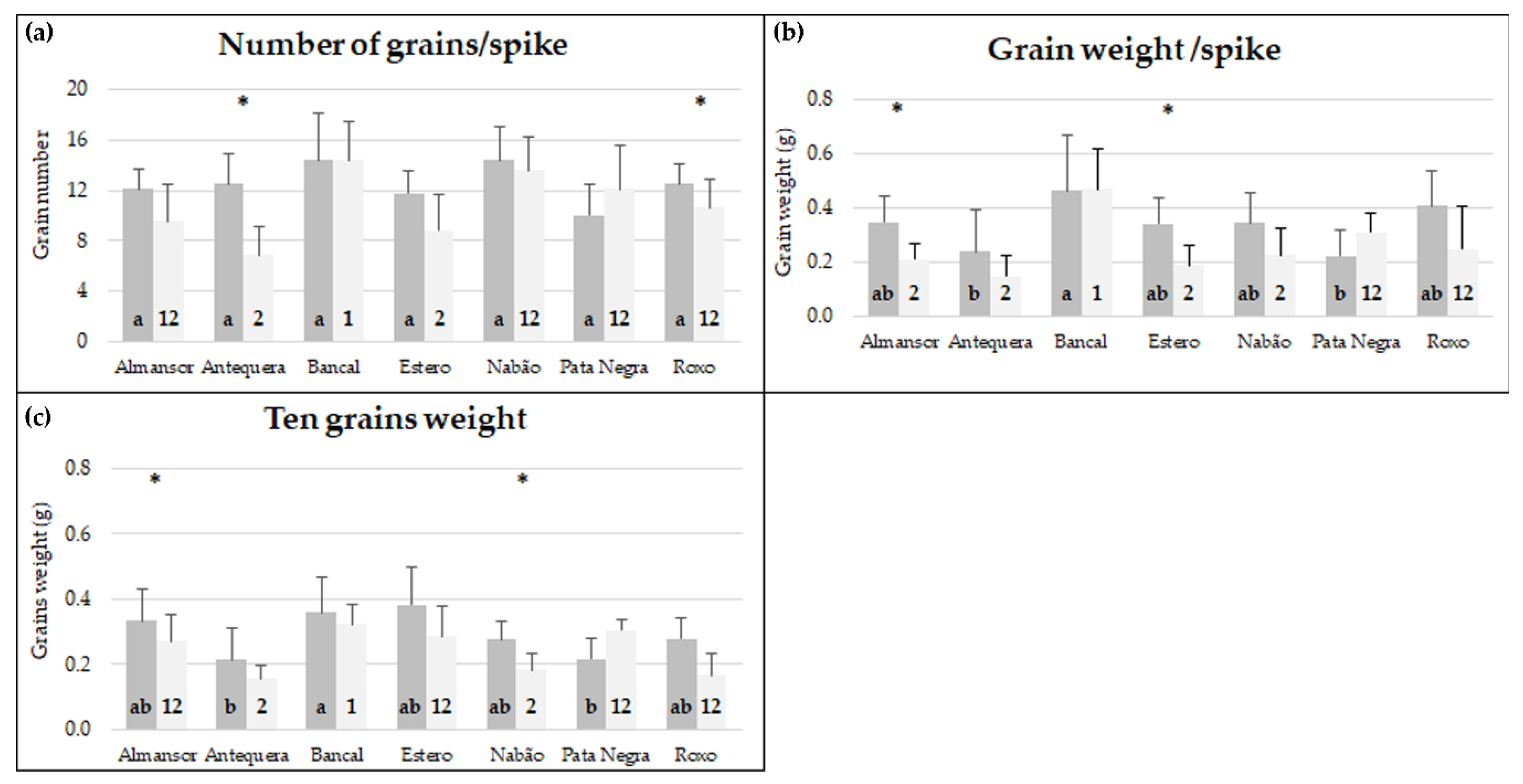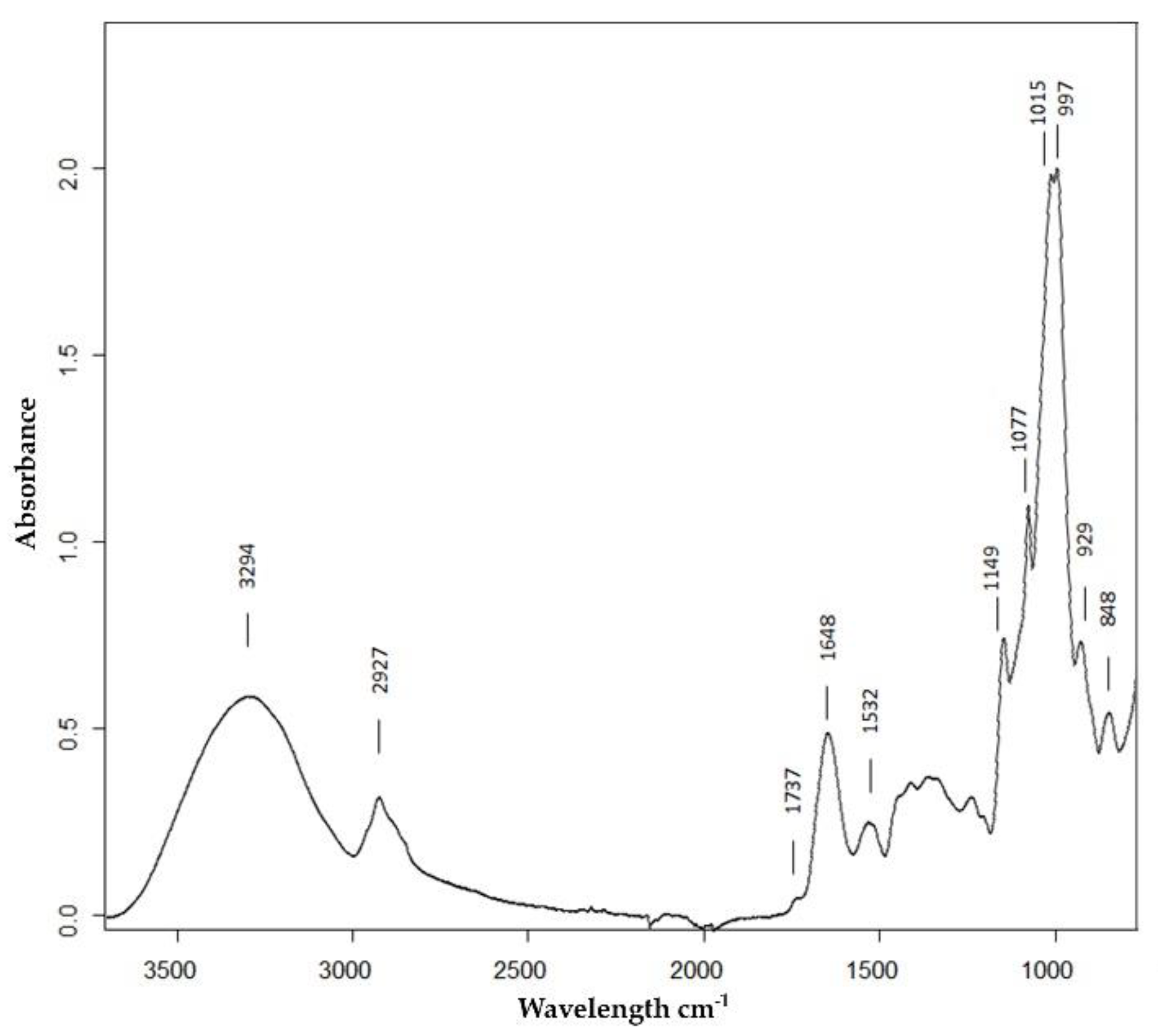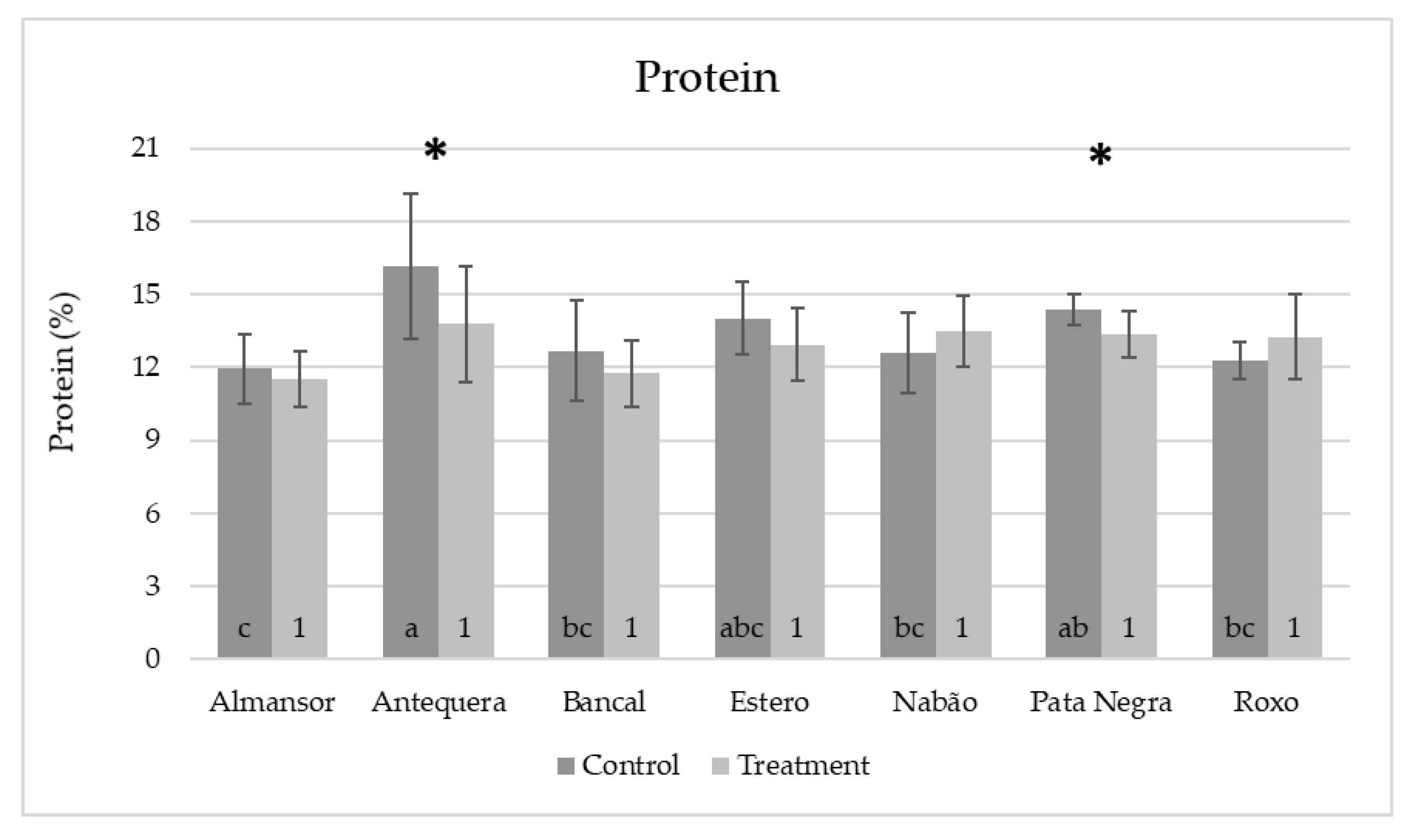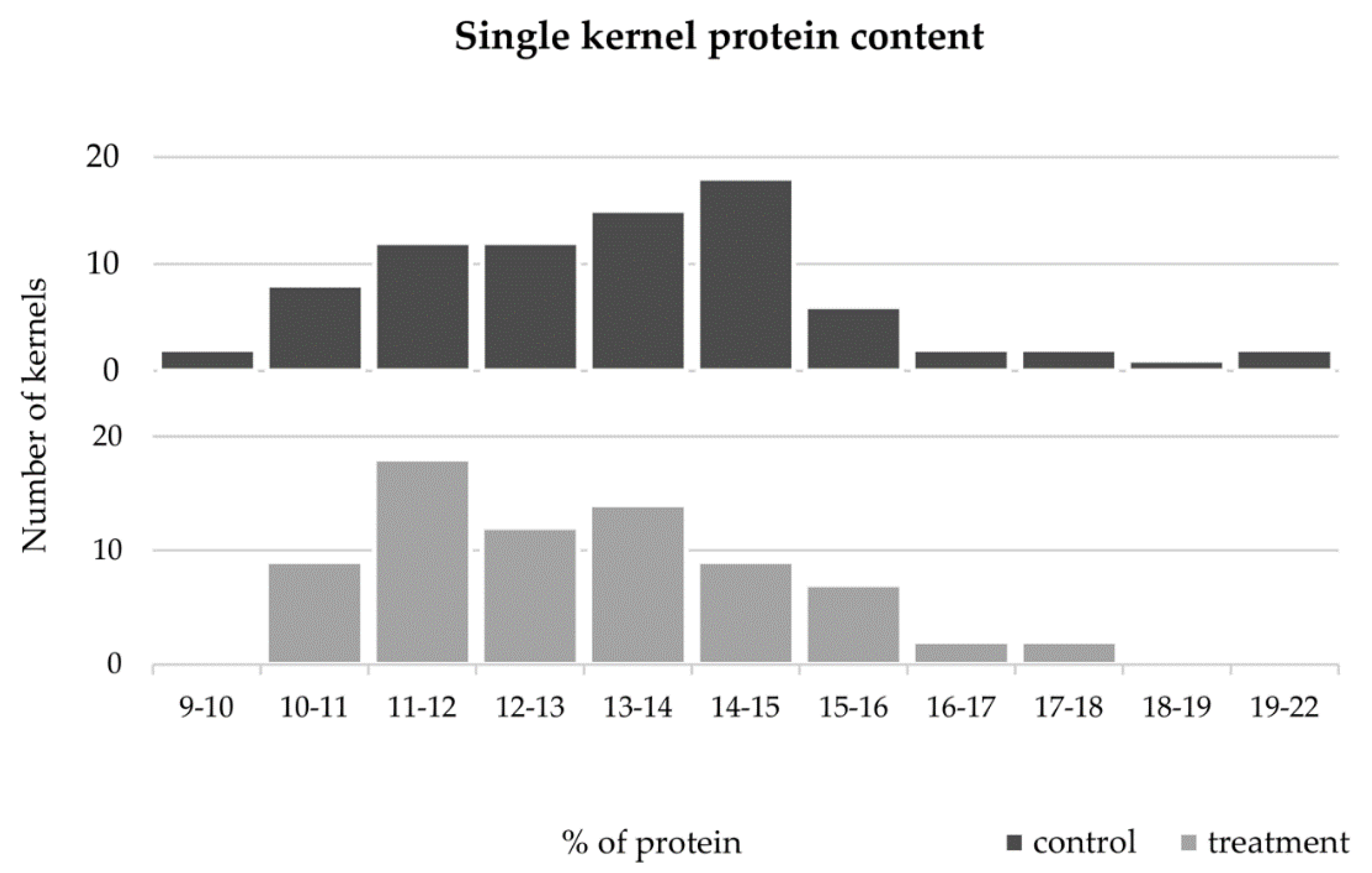Assessment of High Temperature Effects on Grain Yield and Composition in Bread Wheat Commercial Varieties
Abstract
1. Introduction
2. Materials and Methods
2.1. Plant Material
2.2. Yield Evaluation
2.3. ATR-FTIR Spectroscopy
2.4. Elemental Analysis
2.5. Data Analysis
3. Results and Discussion
3.1. HT Treatment Effects on Grain Yield Parameters Disclosed Intervarietal Diversity
3.2. ATR-FTIR Comparison of Control and HT Treated Grains Revealed Complex Responses
3.3. Calibration and Validation of the Model for Nitrogen Content Based on ATR-FTIR Spectra
4. Conclusions
Supplementary Materials
Author Contributions
Funding
Acknowledgments
Conflicts of Interest
References
- FAO FAOSTAT. Available online: http://www.fao.org/faostat/en/#data/QC (accessed on 9 September 2019).
- FAO FAOSTAT. Available online: http://www.fao.org/faostat/en/#data/FBS (accessed on 9 September 2019).
- Tewolde, H.; Fernandez, C.J.; Erickson, C.A. Wheat Cultivars Adapted to Post-Heading High Temperature Stress. J. Agron. Crop Sci. 2006, 120, 111–120. [Google Scholar] [CrossRef]
- Liu, B.; Asseng, S.; Müller, C.; Ewert, F.; Elliott, J.; Lobell, D.B.; Martre, P.; Ruane, A.C.; Wallach, D.; Jones, J.W.; et al. Similar estimates of temperature impacts on global wheat yield by three independent methods. Nat. Clim. Chang. 2016, 6, 1130–1136. [Google Scholar] [CrossRef]
- Akter, N.; Islam, M.R. Heat stress effects and management in wheat. A review. Agron. Sustain. Dev. 2017, 37, 37. [Google Scholar] [CrossRef]
- Farooq, M.; Bramley, H.; Palta, J.A.; Siddique, K.H.M. Heat Stress in Wheat during Reproductive and Grain-Filling Phases. CRC Crit. Rev. Plant Sci. 2011, 30, 491–507. [Google Scholar] [CrossRef]
- Gibson, L.R.; Paulsen, G.M. Yield Components of Wheat Grown under High Temperature Stress. Crop Sci. 1994, 39, 1841–1846. [Google Scholar] [CrossRef]
- Castro, M.; Peterson, C.J.; Rizza, M.D.; Dellavalle, P.D.; Vázquez, D.; IbáÑez, V.; Ross, A. Influence of Heat Stress on Wheat Grain Characteristics and Protein Molecular Weight Distribution. In Wheat Production in Stressed Environments; Springer: Dordrecht, The Netherlands, 2007; pp. 365–371. [Google Scholar]
- Altenbach, S.B. New insights into the effects of high temperature, drought and post-anthesis fertilizer on wheat grain development. J. Cereal Sci. 2012, 56, 39–50. [Google Scholar] [CrossRef]
- Jenner, C. Starch Synthesis in the Kernel of Wheat under High Temperature Conditions. Aust. J. Plant Physiol. 1994, 21, 791. [Google Scholar] [CrossRef]
- Hurkman, W.J.; McCue, K.F.; Altenbach, S.B.; Korn, A.; Tanaka, C.K.; Kothari, K.M.; Johnson, E.L.; Bechtel, D.B.; Wilson, J.D.; Anderson, O.D.; et al. Effect of temperature on expression of genes encoding enzymes for starch biosynthesis in developing wheat endosperm. Plant Sci. 2003, 164, 873–881. [Google Scholar] [CrossRef]
- Corbellini, M.; Mazza, L.; Ciaffi, M.; Lafiandra, D.; Borghi, B. Effect of heat shock during grain filling on protein composition and technological quality of wheats. Euphytica 1998, 100, 147–154. [Google Scholar] [CrossRef]
- Daniel, C.; Triboi, E. Effects of temperature and nitrogen nutrition on the accumulation of gliadins analysed by RP-HPLC. Funct. Plant Biol. 2001, 28, 1197–1205. [Google Scholar] [CrossRef]
- Philippe, S.; Robert, P.; Barron, C.; Saulnier, L.; Guillon, F. Deposition of cell wall polysaccharides in wheat endosperm during grain development: Fourier transform-infrared microspectroscopy study. J. Agric. Food Chem. 2006, 54, 2303–2308. [Google Scholar] [CrossRef] [PubMed]
- Antunes, C.; Mendes, R.; Lima, A.; Barros, G.; Fields, P.; Da Costa, L.B.; Rodrigues, J.C.; Silva, M.J.; Correia, A.M.; Carvalho, M.O. Resistance of rice varieties to the stored-product insect, sitophilus zeamais (Coleoptera: Curculionidae). J. Econ. Entomol. 2016, 109, 445–453. [Google Scholar] [CrossRef] [PubMed]
- Sujka, K.; Koczoń, P.; Ceglińska, A.; Reder, M.; Ciemniewska-Żytkiewicz, H. The Application of FT-IR Spectroscopy for Quality Control of Flours Obtained from Polish Producers. J. Anal. Methods Chem. 2017, 2017. [Google Scholar] [CrossRef] [PubMed]
- Prates, L.L.; Lei, Y.; Refat, B.; Zhang, W.; Yu, P. Effects of heat processing methods on protein subfractions and protein degradation kinetics in dairy cattle in relation to protein molecular structure of barley grain using advanced molecular spectroscopy. J. Cereal Sci. 2018, 80, 212–220. [Google Scholar] [CrossRef]
- Syahariza, Z.A.; Che Man, Y.B.; Selamat, J.; Bakar, J. Detection of lard adulteration in cake formulation by Fourier transform infrared (FTIR) spectroscopy. Food Chem. 2005, 92, 365–371. [Google Scholar] [CrossRef]
- Che Man, Y.B.; Syahariza, Z.A.; Mirghani, M.E.S.; Jinap, S.; Bakar, J. Analysis of potential lard adulteration in chocolate and chocolate products using Fourier transform infrared spectroscopy. Food Chem. 2005, 90, 815–819. [Google Scholar] [CrossRef]
- Singh, V.K.; Devi, A.; Pathania, S.; Kumar, V.; Tripathi, D.K.; Sharma, S.; Chauhan, D.K.; Singh, V.K.; Zorba, V. Spectroscopic investigation of wheat grains (Triticum aestivum) infected by wheat seed gall nematodes (Anguina tritici). Biocatal. Agric. Biotechnol. 2017, 9, 58–66. [Google Scholar] [CrossRef]
- Toole, G.A.; Wilson, R.H.; Parker, M.L.; Wellner, N.K.; Wheeler, T.R.; Shewry, P.R.; Mills, E.N.C. The effect of environment on endosperm cell-wall development in Triticum aestivum during grain filling: An infrared spectroscopic imaging study. Planta 2007, 225, 1393–1403. [Google Scholar] [CrossRef]
- Semenov, M.A.; Shewry, P.R. Modelling predicts that heat stress, not drought, will increase vulnerability of wheat in Europe. Sci. Rep. 2011, 1, 66. [Google Scholar] [CrossRef]
- Teixeira, E.I.; Fischer, G.; van Velthuizen, H.; Walter, C.; Ewert, F. Global hot-spots of heat stress on agricultural crops due to climate change. Agric. For. Meteorol. 2013, 170, 206–215. [Google Scholar] [CrossRef]
- Cardoso, R.M.; Soares, P.M.M.; Lima, D.C.A.; Miranda, P.M.A. Mean and extreme temperatures in a warming climate: EURO CORDEX and WRF regional climate high-resolution projections for Portugal. Clim. Dyn. 2019, 52, 129–157. [Google Scholar] [CrossRef]
- ANPOC; INIAV; IpBeja; Ceres; Germen. Cerealis Lista de Variedade Recomendadas Sementeiras Trigo Mole; Lisboa, Portugal, 2014. [Google Scholar]
- Williams, P.C.; Sobering, D.C. Comparison of Commercial near Infrared Transmittance and Reflectance Instruments for Analysis of Whole Grains and Seeds. J. Near Infrared Spectrosc. 1993, 1, 25–32. [Google Scholar] [CrossRef]
- Stone, P.J.; Nicolas, M.E. A survey of the effects of high temperature during grain filling on yield and quality of 75 wheat cultivars. Aust. J. Agric. Res. 1995, 46, 475–492. [Google Scholar] [CrossRef]
- Hays, D.B.; Do, J.H.; Mason, R.E.; Morgan, G.; Finlayson, S.A. Heat stress induced ethylene production in developing wheat grains induces kernel abortion and increased maturation in a susceptible cultivar. Plant Sci. 2007, 172, 1113–1123. [Google Scholar] [CrossRef]
- Shewry, P.R. Wheat. J. Exp. Bot. 2009, 60, 1537–1553. [Google Scholar] [CrossRef]
- Tomás, D.; Viegas, W.; Silva, M. Effects of Post-Anthesis Heat Waves on the Grain Quality of Seven European Wheat Varieties. Agronomy 2020, 10, 268. [Google Scholar] [CrossRef]
- Warren, F.J.; Perston, B.B.; Galindez-najera, S.P.; Edwards, C.H.; Powell, P.O.; Mandalari, G.; Campbell, G.M.; Butterworth, P.J.; Ellis, P.R. Infrared microspectroscopic imaging of plant tissues: Spectral visualization of Triticum aestivum kernel and Arabidopsis leaf microstructure. Plant J. 2015, 84, 634–646. [Google Scholar] [CrossRef]
- Carver, B.F. The Biochemical and Molecular Basis of Wheat Quality. In Wheat: Science and Trade; World Agriculture Series; Wiley: Hoboken, NJ, USA, 2009; pp. 495–520. [Google Scholar]
- Caporaso, N.; Whitworth, M.B.; Fisk, I.D. Protein content prediction in single wheat kernels using hyperspectral imaging. Food Chem. 2018, 240, 32–42. [Google Scholar] [CrossRef]
- Mitchell, J.; Johnston, I.G.; Bassel, G.W.; Penfield, S. Variability in seeds: Biological, ecological, and agricultural implications. J. Exp. Bot. 2016, 68, 809–817. [Google Scholar] [CrossRef]
- Daniel, C.; Triboi, E. Effects of temperature and nitrogen nutrition on the grain composition of winter wheat: Effects on gliadin content and composition. J. Cereal Sci. 2000, 32, 45–56. [Google Scholar] [CrossRef]






| Variety | Condition | Wavelength (cm−1) | ||||||||||
|---|---|---|---|---|---|---|---|---|---|---|---|---|
| Protein/Saccharides O–H; N–H ~3294 | Fat/Saccharides CH2 ~2927 | Fat C=O ~1737 | Amide I ~1648 | Amide II ~1532 | Saccharides | |||||||
| ~1149 | ~1077 | C–H ~1015 | C–H ~997 | ~929 | ~848 | |||||||
| Almansor | C | − | + | + | + | + | + | + | + | =2 | + | + |
| HT | + | − | − | − | − | − | − | − | =2 | − | − | |
| Antequera | C | − | − | ~ | ++ | ++ | + | + | =2 | ++ | −− | −− |
| HT | + | + | ~ | −− | −− | − | − | −− | =2 | ++ | ++ | |
| Bancal | C | = | + | + | + | + | = | + | + | =2 | ~ | ~ |
| HT | = | − | − | − | − | = | − | − | =2 | ~ | ~ | |
| Estero | C | + | + | + | ++ | ++ | ~ | + | =2 | ~ | ~ | + |
| HT | − | − | − | −− | −− | ~ | − | ~ | =2 | ~ | − | |
| Nabão | C | − | − | ~ | −− | −− | − | − | + | =2 | −− | −− |
| HT | + | + | ~ | ++ | ++ | + | + | − | =2 | ++ | ++ | |
| Pata Negra | C | + | + | + | + | + | − | ~ | =2 | ~ | − | − |
| HT | − | − | − | − | − | + | ~ | ~ | =2 | + | + | |
| Roxo | C | − | ~ | ~ | ~ | ~ | − | − | − | =2 | −− | −− |
| HT | + | ~ | ~ | ~ | ~ | + | + | + | =2 | ++ | ++ | |
© 2020 by the authors. Licensee MDPI, Basel, Switzerland. This article is an open access article distributed under the terms and conditions of the Creative Commons Attribution (CC BY) license (http://creativecommons.org/licenses/by/4.0/).
Share and Cite
Tomás, D.; Rodrigues, J.C.; Viegas, W.; Silva, M. Assessment of High Temperature Effects on Grain Yield and Composition in Bread Wheat Commercial Varieties. Agronomy 2020, 10, 499. https://doi.org/10.3390/agronomy10040499
Tomás D, Rodrigues JC, Viegas W, Silva M. Assessment of High Temperature Effects on Grain Yield and Composition in Bread Wheat Commercial Varieties. Agronomy. 2020; 10(4):499. https://doi.org/10.3390/agronomy10040499
Chicago/Turabian StyleTomás, Diana, José Carlos Rodrigues, Wanda Viegas, and Manuela Silva. 2020. "Assessment of High Temperature Effects on Grain Yield and Composition in Bread Wheat Commercial Varieties" Agronomy 10, no. 4: 499. https://doi.org/10.3390/agronomy10040499
APA StyleTomás, D., Rodrigues, J. C., Viegas, W., & Silva, M. (2020). Assessment of High Temperature Effects on Grain Yield and Composition in Bread Wheat Commercial Varieties. Agronomy, 10(4), 499. https://doi.org/10.3390/agronomy10040499







